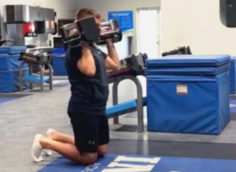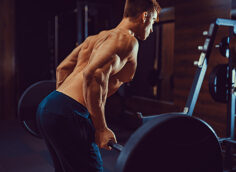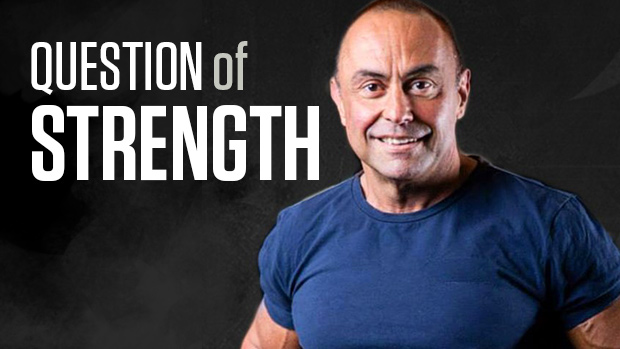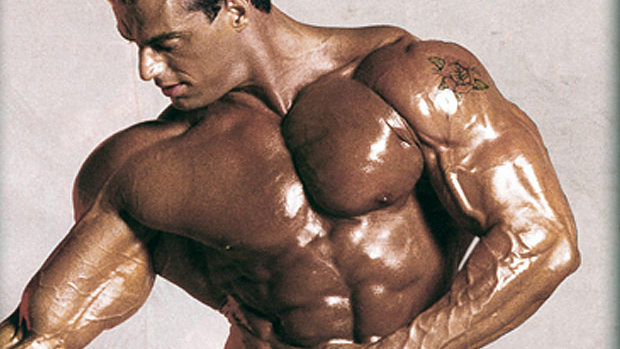The Smith machine is about the most misunderstood piece of gym equipment. Admittedly, it can make for dangerous and unnatural squatting and pressing, but with just a few tweaks it can also be an excellent hypertrophy tool while providing a nice change of pace from the usual routine.
So why do so many people have a hate-on for the Smith machine?
- The plane of motion is fixed. Experts argue that it's unnatural for your body to exercise through a fixed plane. For example, when you squat, it's more "natural" to use other joints (hip and ankle) outside of just the knee joint.
- Here's my perspective: what if I want to use only one joint and focus on a single muscle group?
- For example, I can use Smith machine squats to focus on the quads by placing my feet out in front. This is great for people with overdeveloped glutes and hips (big caboose/small quads syndrome). So by doing so, I'm creating better muscle balance, not making it worse.
- Or what if someone has a bad back and needs to stay more upright when they squat? The Smith machine can allow you to still squat despite the back injury.
- It's not functional. I'm not even sure what this means. Does functional mean like in everyday life? If so, when's the last time you did a power clean or a snatch in "real life?" Sorry, I'm not buying that argument. If your primary goal is to simulate the movement patterns we do every day, then let's do some "one arm bend over to pick up your gym bags" or a few "hold a weight up to your ears" to simulate talking on a cell phone. Enough said.
- You don't develop the stabilizer muscles. Okay, so what if I don't want to engage stabilizer muscles? The name of my game is hypertrophy. I want big quads, period. I'm not saying to ditch exercises that heavily recruit the stabilizers like squats, chin-ups, dumbbell rows, etc. I'm just saying that avoiding the Smith machine for this reason is weak.
- Here's something else to consider. What if your stabilizers are injured and you want to avoid them? Know anyone with perpetually sore shoulder joints? I'll bet that regular flat and incline benches are painful for them, but they can likely do Smith machine presses.
- Because somebody I know said they suck. This is probably the biggest reason why lifters don't use the Smith machine. If you're the type that listens to others without trying things, then you have to listen to me on this, and try the Smith machine the way I describe!
The Why
- Hypertrophy. The fixed plane of motion the Smith machine employs is beneficial in hammering a muscle into submission. The constant tension is particularly good.
- Prevention of staleness. I don't know how lifters can do the same thing for years on end (unless they're making great progress the whole time). Training should be fun and interesting or you'll eventually get bored and quit.
- Furthermore, people underestimate the body's ability to adapt to a specific stress. This is especially important for advanced lifters. By mixing in some of the exercises I describe below, you can continue to grow and make progress.
- Safety. Provided your form and body alignment is dialed in, the Smith machine is not as taxing as regular free weight movement on your joints.
The When
There are no set rules on the frequency of using the Smith machine, but I generally use it one out of every four workouts for a bodypart such as chest, legs, or back. My routines for intermediate and advanced trainees involve a lot of exercise rotation, so I rotate these in.
The Who
- Advanced and intermediate trainees only. You need to understand how to use the Smith machine correctly to derive the maximum benefit. Beginners should focus on learning basic barbell and dumbbell movement patterns and developing a strong base.
- No feelers. For those who can't "feel" a muscle working, the Smith machine is an excellent way to overcome that. The fixed plan of motion allows you to really focus on the intended muscle without having to worry about balance and others factors.
The How
I follow two simple rules when using the Smith machine:
- Never start with the Smith machine except for back training. Place it strategically in your program. In short, perform Smith work with an already pumped muscle.
- Master form to get the most out of it. You have to have a "trainer's eye." You need to see the angles the bar should travel at and line yourself up accordingly. I'll provide some instruction in the videos below so you can master this yourself.
Okay, let's get down to business.
The Smith Machine Revisited
Here are a few body part routines that include some of my favorite Smith machine exercises and some additional thoughts on execution and where to place them in your routine.
Incline Smith Press
These should be placed second or third in your routine, behind a machine press or dumbbell press. Barbell chest exercises should rarely be done first – it won't negatively affect growth and it will definitely keep your joints healthier.
You need to have the bar travel down at a perfect angle. Watch the video and listen to the commentary to see what I mean.
Also, don't touch the chest. I've seen this result in many strained and overworked rotators. Basically, for best results keep continuous tension on the muscle. Use an angle that's not too steep to further reduce shoulder stress, like 20-25 degrees.
Decline Smith Press
Again, place these second or third in your routine. Use a slight decline to avoid shoulder stress. Watch the video and pay attention to where the bar is traveling. These will give you a massive chest pump.
Note: The Smith machine allows for safe drop sets and high rep sets. These are great ways to increase intensity and spur new muscle growth.
Sample Chest Routines
Chest Routine A
| Exercise | Sets | Reps | |
|---|---|---|---|
| A | Incline Dumbbell Press on low Angle | 3 | 8 |
| Do a few warm up sets, pyramiding up in sets of 8. Don't lock out; keep continuous tension. Keep going up until you can't get eight reps. Count the last three sets as work sets. | |||
| B | Incline Barbell Press | 3 | 8 |
| Pyramid up in sets of eight reps until you can't get eight. Don't lock out. Count the last three sets as work sets. | |||
| C | Smith Machine Decline Bench Press | 4 | 8 |
| Use a slight angle. Put on a weight that you can do 10 reps with. Pause for one second on your chest and then drive to 3/4 lockout. Do three sets total like this; for your fourth use a weight that's a tough 8 reps. Do 8 reps with it, drop the weight, then do 8 more reps. Now drop the weight again. Widen your grip, and pump out reps to complete failure. | |||
| D | Stretch Push-up | 3 | failure |
| Do three sets to failure. Keep your chin up and try to touch the floor with your chest. | |||
Chest Routine B
| Exercise | Sets | Reps | |
|---|---|---|---|
| A | Banded Hammer Press | 4 | 8 |
| Do a few warm up sets to get started, then do four sets of 8 reps. I'm not really concerned which machine you use, just be sure to flex hard for one second on every rep. | |||
| B | Smith Machine Incline Bench Press | 4 | 15,12,9,6 |
| Use a slight angle of 20-25 degrees. Don't lock out. Keep continuous tension on the muscle. Stop short of touching your chest by an inch or two. I want you to pyramid up. Use this rep scheme: 15, 12, 9, and 6. | |||
| C | Reverse Band Bench | 5 | 5 |
| Use a weight that allows you to complete all reps. | |||
Back
I love using the Smith machine for barbell rows, and consider them better than free weight barbell rows. I've seen many lifters deadlift and shrug in the Smith machine, but I'm going to agree with the naysayers on these two exercises. They just don't feel right.
Smith Machine Barbell Row
These are bad to the bone once you figure out how to do them. You can also set up the "stops" so you can "enjoy" a dead-stop version.
The main point is to pull the bar into your abs – just a shade above the bellybutton – by driving the elbows up. Don't pull the bar up with the arms – drive with your elbows.
As with any row, keep your back flat and tight and wear a belt. Watch the video, especially the last set in the drop set, and see how my body position is fixed and I'm just driving with my elbows.
Sample Back Routine
| Exercise | Sets | Reps | |
|---|---|---|---|
| A | Smith Machine Bent Over Row | 4 | 8 |
| After a few warm ups, do sets of 8 reps working up to a heavy weight. Once there, do three sets of 8 reps. On the fourth set, do 6 reps, then drop the weight and do 6 more reps, drop the weight and go to failure. Focus on driving your elbows up hard. | |||
| B1 | Parallel Grip Pulldown | 4 | 8 |
| Do sets of 8 with a hard flex in the contracted position. Use a grip where your palms face each other. | |||
| B2 | Dumbbell pullovers | 4 | 10 |
| C | Reeves Deadlift | 8 | 5 |
| Work up to a tough five reps. Do five sets of 5 reps with it. Then add weight and do three sets of 3 reps. Explode on these. | |||
| D | Banded Hyperextension | 2 | failure |
Triceps
An awesome triceps exercise on the Smith machine is an incline bench version of the JM press, made famous by powerlifting great JM Blakely. Do these last to help keep the elbows healthy.
Incline Smith JM Press
Watch the angle in which I lower the bar. These put tremendous strain on the triceps. Again, do these last, once your triceps and elbows are loaded with blood. If you do, you'll reap the benefits of these.
Sample Triceps Routine
| Exercise | Sets | Reps | |
|---|---|---|---|
| A1 | V-Bar Pushdown | 4 | 10 |
| Do a few sets to get warmed up. Do 10 hard reps with a flex at the bottom of every rep. | |||
| A2 | Seated Dip Machine | 4 | 8 |
| Do sets of 8 reps with a three-second negative. Control the weight, crush the triceps. Only rest 60 seconds then start again. | |||
| B | Incline Smith Machine Triceps Extension | 4 | 8 |
| Similar to a JM press, your elbows should be plenty warm first. Do 1-2 warm up sets to get the feel. Lower the bar down toward your nose and drive back up. Let the elbows flare out a tad, but not too wide – keep them more tucked as in a close grip press. Pause each rep at the bottom 2-3 inches above your nose. | |||
Legs
There are many ways to include the Smith machine in your leg workouts. Here are some of my favorite exercises.
Smith Machine Squat
Many lifters can't do free weight squats due to back issues but thrive on Smith machine squats.
I wouldn't do these first. They just feel better, and more effective when performed third or fourth in the routine. The most common mistake lifters make is not getting their feet out in front of them far enough. It might feel a little strange during the setup, but it's the right way to align your body. The shins won't shoot forward and you can keep your back incredibly straight.
You can also do drop sets with the Smith machine or my infamous 1.5 squats. This is going down deep, coming up half way, going back down deep, and then coming up all the way. That's one rep. I can't count how many tough guys I've seen crumple into the fetal position when doing these correctly.
Smith Machine Lunge
This has become one of my favorite ways to lunge. Talk about being aligned perfectly – you don't have dumbbells swinging forward, excessive forward lean, momentum, etc. – you just get in the machine and grind it out. In the video, you'll see these supersetted with squats, a deadly combination.
Sample Legs Routine
Leg Routine A
| Exercise | Sets | Reps | |
|---|---|---|---|
| A | Lying Leg Curl | 4 | 12,10,8,10(25) |
|
Have someone gently push down on your lower back while you do these to help keep your hips down. You won't be able to lift as much weight, but it will help isolate them. Do two warm up sets followed by one set of 12 reps. Then start increasing the load; a set of 10, add weight, then a set of 8. Rest about 90 seconds between sets.
For the fourth set, go back to the weight you did for 12 reps and do 10 reps, then drop a plate and do 10 more reps, drop a plate and do 10 reps, and then do 25 partial reps out of the bottom. Just start the weight up and come back down – the weight will only be moving 2-3 inches, but the constant tension will make your hamstrings scream. |
|||
| B | Leg Press | 3 | 10 |
|
Place your feet low on the platform and slightly wider than shoulder width. Start with one plate on each side – you should feel it in the hamstrings and inner thighs during the descent. Keep adding weight and hitting sets of 10 reps until you can't get 10 reps anymore. That will be your work weight.
During the work sets, take three seconds to perform the eccentric phase before driving the weight up explosively. Do three hard sets of this. Don't lock out – keep constant tension on the thighs for maximum effect! |
|||
| C | Smith Machine 1.5 Squat | 3 | 10 |
| The goal here is constant tension so this won't require much weight. Go down to rock bottom, come up half way, then back down to rock bottom before coming all the way back up. That's one rep. | |||
| D | Smith Machine Stiff Leg Deadlift | 3 | 10 |
| Load the machine with 25-pound plates to get a better stretch and bend your knees slightly at the bottom. Do two warm ups to get stretched out, then find a good weight that you can use for three sets of 10. Flex your glutes and hams hard at the top on every rep. | |||
Leg Routine B
| Exercise | Sets | Reps | |
|---|---|---|---|
| A | Lying Leg Curl | 4 | 12 |
| Do 2-3 warm up sets, then perform four sets of 12 with 60-second breaks between sets. Nothing fancy here, just get all your reps. You may have to pause a few times mid-set to hit 12 reps, especially in sets three and four. | |||
| B | Banded Leg Press * * | 3 * | 8 |
| Make sure you do plenty of warm up sets. Do sets of eight reps and keep adding weight until eight reps is challenging. Then do three sets of eight reps. Use two sets of monster minis (black bands) and one set of Pro minis (red bands). | |||
| C1 | Smith Machine Lunge | 3 | 8 |
| Do four reps on one leg, then quickly switch to the other leg and do four reps. Then go back to the other leg and do four reps, then four on the other. Each leg gets 8 total reps so you don't have one leg that's significantly more annihilated than the other when you squat, plus you can use heavier weight. Increase the weight after each set of lunges as you'll be supersetting the lunges with Smith machine squats. | |||
| C2 | Smith Machine Squat | 3 | 8 |
| Throw a 45-pound plate on top of your lunging load and do 8 deep reps. For example, use 25 pounds on each side for the first set of lunges, and then add a 45-pound plate for the deep Smith machine squats. On the next set do 35 pounds on each side for lunges, and then add a 45-pound plate on top for squats, etc. These are tough. | |||
| D | Barbell Stiff Legged Deadlift | 2 | 15 |
| Don't lock out. Go up 3/4 of the way and then come back down. Maintain constant tension on the hamstrings. | |||
Additional Notes
Biceps
I don't like anything for biceps on the Smith machine. I tried drag curls, but even those didn't feel right.
Shoulders
I'm not a fan of upright rows, and rarely use the Smith machine for overhead pressing. If I do, it's a partial rep press from the top of the head.
Wrap Up
I don't expect anyone to scrap the basic lifts from their routine in favor of the Smith machine exercises, nor do I think that's necessary or even ideal. The Smith machine is simply a tool, and in the right context, a very effective one. My hope is that you'll try some of the exercises and routines you've read here and decide for yourself.





